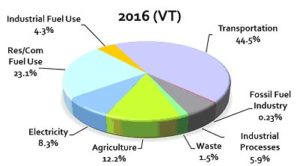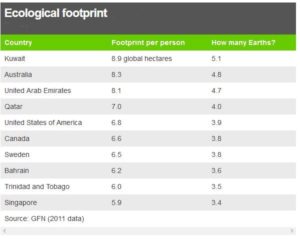Of course, things are never that simple.
It has been argued here that “Big oil coined ‘carbon footprints’ to blame us for their greed“.
And conversely that “Yes, Actually, Individual Responsibility Is Essential to Solving the Climate Crisis” (Sierra Club).
Here is an A to Z guide “Climate Change from A to Z: The stories we tell ourselves about the future. By Elizabeth Kolbert, November 21, 2022” in the New Yorker
So let’s assume that personal actions and collective actions and government policy (and lobbying for change) are all important. OK?
What is your carbon footprint, and how to reduce it?
 Your carbon footprint is your total greenhouse gas emissions caused by your lifestyle, expressed as carbon dioxide equivalent.
Your carbon footprint is your total greenhouse gas emissions caused by your lifestyle, expressed as carbon dioxide equivalent.
Why determine your climate footprint? Learn where you can have the most impact, set goals for reduction, track your progress.
We all want to take action – start by examining, understanding your own personal impact; then you’ll become a better advocate for collective change at State, National and Global levels!
Calculating your carbon footprint requires taking lots of different factors into account. You may not be able to get an exact figure, but you can get a close estimate.
These are 4 major contributors to a person’s carbon footprint:
Here are Carbon footprint calculators from three different organizations: Carbon Footprint Ltd., CoolCalifornia, and Global Footprint Network;
Requires a very thorough searching for values (e.g. $$s spent in 14 categories of Consumption. It has great tips.
Has ‘real time’ histogram display of your CO2 emissions, and has ‘sliders’ and simple/advanced options for input. The ‘Reduce your Impact’ actions are helpful (give upfront cost and annual $ savings).
Quick and easy to use. Allows you to input estimates (without getting actual values), but the “solutions” are complicated, theoretical and individual actions are unclear.
Tips for reducing your Carbon Footprint – these are the major contributors:
- Choosing where your home and work are located (reduce transport)
- Choice of diet – meat-based vs. plant-based
- Choosing what vehicle to buy
- Choosing your lodging (reduce heating/cooling)
- Choosing how many children to have
Transport:
Share rides, Carpool, combine trips, walk, use a bike, or public transport or a combination. Active Transportation (walk, bike) is more healthy!
Consider owning or leasing an electric vehicle (EV). Information here;
Or how about an electric bike? – ‘loaners’ available from Local Motion.
Speed Kills – and More!
Yes, in a crash, more speed means more damage. And also, the faster you drive, the more fuel is burned (so more exhaust, more global warming).
For highway driving fuel consumption is typically 17% more at 70 mph compared to 55 mph, depending on the vehicle.
And of course bigger vehicles burn more fuel – In the US, SUVs emit 14 percent more carbon dioxide than small passenger cars on average.
And SUV’s are more likely to kill pedestrians.
Heating and home energy:
If you own a home, get an energy audit to show where you are losing heat, and the cost effectiveness of improvements;
Consider an electric heat pump for space heating and water heating (incentives available!)
Consider adding rooftop solar (Photo-voltaic), or join a community solar project.
Food and diet:
A plant-based diet has a much lower environmental impact than meat-based, and is probably more healthy. Buy locally-produced food – at the Farmers’ Market and local CSAs and farm stands.
Consumption/Waste:
The 4 ‘Rs’ – Reuse, Reduce, Repair, Recycle
- Support businesses that minimize their climate impact
- Buy ENERGY STAR appliances and products
- Avoid buying products with wasteful packaging
Advocacy Resources – Encourage our legislators!
Climate advocacy with Vermont Natural Resources Council:
Climate advocacy with Energy Independent Vermont
This chart shows how Vermonters compare to our neighbors in per-capita emissions (Metric Tons of CO2 Equivalent):
And a pie chart showing the huge contribution from transportation.
How many Earths’ resources do we need to support our lifestyle?
https://www.footprintnetwork.org/ and https://www.bbc.com/news/magazine-33133712

Environmental costs of meat-based and plant-based burgers
(costs per quarter-pound, to nearest integer)
|
Type of Burger |
GHG emissions (pounds CO2equiv) | Water (gallons) | Land (sq feet) | GMO ingredients or inputs |
| Industrial Beef Burger | 12 | 153 | 58 | Yes |
| Grass-fed Beef Burger | -1 to 9 | 59 | 120 | No |
| ‘Beyond Burger’ | 1 | 1 | 5 | No |
| Morningstar Farms Griller, Original Burger | 2 | 1 | 6 | Yes |
| ‘Impossible Burger’ | 1 | 3 | 3 | Yes |
Source: ‘Sierra’magazine, March/April 2020. Sierra Club, Oakland, CA
Efficiency Vermont: How to reduce your carbon footprint at home:
https://www.efficiencyvermont.com/blog/how-to/how-to-reduce-your-carbon-footprint-at-home




